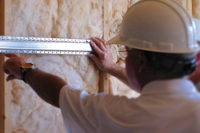If you’re looking to avoid ceiling cracking, the industry’s leading authority is recommending resilient channel as a solution. The Gypsum Association released a technical document, GA-227-13, “Recommendations for the Prevention of Ceiling Cracking.” Their publication outlines methodologies for mitigating cracking in large span gypsum board ceilings due to fluctuations in temperature and humidity. According to Stan Roller of the National Council of Acoustical Consultants, resilient channel was not originally designed to provide improved sound attenuation, but rather to avoid cracks in the drywall where the direction of the framing changes.
Ceiling cracks at wallboard joints can pose a problem in a variety of conditions, including when the span between framing members is close to or extends past 15 feet. Additionally, centerline cracks can occur because gypsum board and wood framing shrink and expand at different rates due to changes in moisture content and temperature. Installation of resilient channel can reduce this cracking. Resilient channels float the panels away from studs and joists, and provide a spring action that isolates the gypsum board from the framing. This spring action also tends to level the panel when installed over uneven framing as well as provides good sound attenuation.
Installation—Ceilings
Resilient channel should be attached at right angles (90 degrees) to wood trusses or joists 16 inches-on-center with 1¼-inch Type W or 1¼-inch Type S screws (nails are not recommended.) The open side of the resilient channels should always be installed the same direction and attached at each intersection. Start the installation with the center of the face of the channel 6 inches from the wall and end 6 inches from the opposite side. It may require that the last channel spacing is less than 16 inches. This permits a floating angle wallboard installation.
When splices are required, splice channels directly over the joist or truss by overlapping not butting the channel. Drive screw through both flanges into the joist or truss.
When there is a change in direction of the joist or truss creating a girder, blocking should be used 24 inches-on-center on the shorter joist or truss run. This permits the channels to continue to run in the same direction. This method of resilient channel framing permits the wallboard to be installed continuously in the same direction spanning the girder. (Do not splice at girder.)
If no blocking is used, then the channels must be installed at right angles to the framing member 16 inches-on-center. Thus, the wallboard may continue in the same direction as the resilient channels. The 16 inches-on-center installed resilient channel may be considered the framing member.
Cathedral Ceiling Installation
Resilient channel should be installed on Cathedral Ceilings (single or double angled ceiling) with the center of the face of the channel 6 inches from the top to permit a floating angle wallboard installation. Resilient channel must be installed with mounting flange down.
Where the bottom cord of the trusses are spliced, use a 20 gauge knurled angle runner to span a minimum of 5 feet. (2½ feet each side of truss splice.) The resilient channels should then be attached to the trusses or joists through the 20 gauge knurled angle runner into the wooden trusses or joists.
Butt Joints
The resilient channel must be installed parallel and at 90 degrees to the wall 16 inches-on-center for butt joints. The ends of the wallboard must meet at the center of the wall board mounting face on the resilient channel.
Installation of Gypsum Board
Gypsum board should be installed perpendicular to the joist or truss because it offers the following advantages:
- Strongest dimension of wallboard runs across framing members
- Bridges irregularities in alignment and spacing of frame members
- Better bracing strength—each board ties more framing members together than does parallel application
Install wallboard perpendicular to the channel with 1-inch Type S Buglehead for ½-inch board and 1 1/8-inch Type S Buglehead on 5/8-inch board 12 inches maximum on-center. Screws used to attach wallboard to resilient channels shall not contact wood joist or truss. Stagger every other board and use the longest wallboard practicable. Avoid butt joints if possible.
Floating Angle Installation
Floating angles should be created. The first fastener attaching the wallboard to the resilient channel should be 6 inches from the wall. When attaching the wall board to the side wall the first fastener should be 6 inches from the ceiling.
The foregoing is presented for general application in the installation of resilient channel. The installation and specifications must be reviewed and approved by the builder’s design professional to verify suitability for each particular installation.
References
- Gypsum Association technical document, GA-227-13
- National Council of Acoustical Consultants Fall 2002 Newsletter
- Gypsum Construction Handbook (USG)
- ICBO Evaluation Report ER-1632
- Uniform Building Code Manual
- Gypsum Association Fire Resistance Design Manual
- Western Pacific Distributing Wallboard Joint Deformation Handbook









Report Abusive Comment